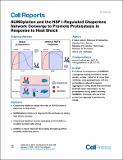| dc.contributor.author | Liebelt, Frauke | |
| dc.contributor.author | Sebastian, Rebecca M | |
| dc.contributor.author | Moore, Christopher L | |
| dc.contributor.author | Mulder, Monique PC | |
| dc.contributor.author | Ovaa, Huib | |
| dc.contributor.author | Shoulders, Matthew D | |
| dc.contributor.author | Vertegaal, Alfred CO | |
| dc.date.accessioned | 2021-10-27T20:11:00Z | |
| dc.date.available | 2021-10-27T20:11:00Z | |
| dc.date.issued | 2019 | |
| dc.identifier.uri | https://hdl.handle.net/1721.1/135158 | |
| dc.description.abstract | © 2018 The Author(s) Functional consequences of SUMO2/3 conjugation during proteotoxic stress remain unclear. Liebelt et al. show that SUMO2/3 acts synergistically with the proteostasis network to reduce aggregation during acute heat shock and facilitate target degradation by the proteasome during stress recovery. SUMO2/3, therefore, acts as a first protective response to proteotoxic stress. | |
| dc.language.iso | en | |
| dc.publisher | Elsevier BV | |
| dc.relation.isversionof | 10.1016/J.CELREP.2018.12.027 | |
| dc.rights | Creative Commons Attribution-NonCommercial-NoDerivs License | |
| dc.rights.uri | http://creativecommons.org/licenses/by-nc-nd/4.0/ | |
| dc.source | Elsevier | |
| dc.title | SUMOylation and the HSF1-Regulated Chaperone Network Converge to Promote Proteostasis in Response to Heat Shock | |
| dc.type | Article | |
| dc.contributor.department | Massachusetts Institute of Technology. Department of Chemistry | |
| dc.relation.journal | Cell Reports | |
| dc.eprint.version | Final published version | |
| dc.type.uri | http://purl.org/eprint/type/JournalArticle | |
| eprint.status | http://purl.org/eprint/status/PeerReviewed | |
| dc.date.updated | 2020-09-22T16:21:00Z | |
| dspace.orderedauthors | Liebelt, F; Sebastian, RM; Moore, CL; Mulder, MPC; Ovaa, H; Shoulders, MD; Vertegaal, ACO | |
| dspace.date.submission | 2020-09-22T16:21:03Z | |
| mit.journal.volume | 26 | |
| mit.journal.issue | 1 | |
| mit.license | PUBLISHER_CC | |
| mit.metadata.status | Authority Work and Publication Information Needed | |
